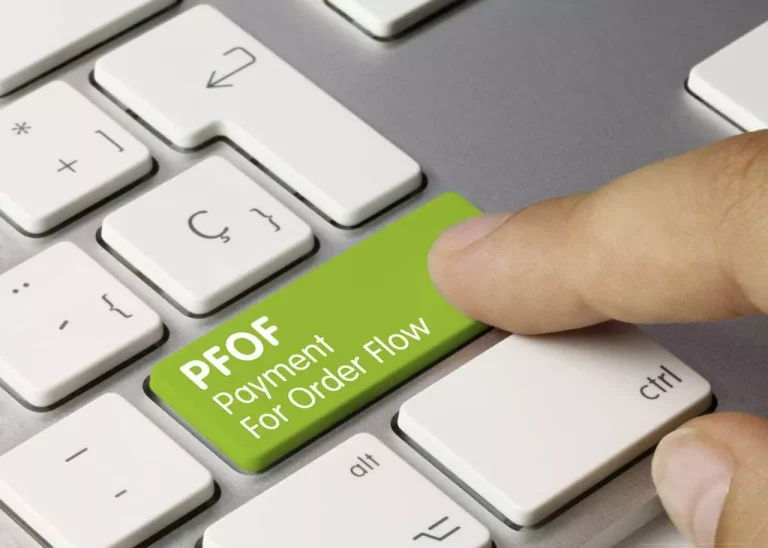The Truth About Payment for Order Flow in Canada
Content
Payment for order flow (PFOF)is compensation that pfof meaning broker-dealers receive in exchange for placing trades with market makers and electronic communication networks, which aim to execute trades for a slight profit. Investors could be paying fees unwittingly for their “no-commission” trades. In 2021, the SEC expressed concern about orders flowing to the dark market, where the lack of competition among market makers executing trades could mean that brokerages and their customers are being overcharged. Most estimates suggest that about half of all equity options trades by volume now come from retail investors, with estimates from the New York Stock Exchange in December 2023 putting it at 45% in July of that year. Grasping how PFOF works enables investors to appreciate how no trade is really free because if they aren’t paying for the services involved in trading, then someone else is.

What Is Payment for Order Flow (PFOF) And How Can It Affect Traders?
- PFOF is how brokers get paid by market makers for routing client orders to them.
- Some retail brokerages that target more informed investors do not engage in PFOF.
- Two critical concepts that traders, investors, and regulators often discuss are Payment for Order Flow (PFOF) and Best Execution.
- I am attracted to Robinhood because of the IRA 1-3% contribution match (and no commissions), but am starting to learn about the ugly truth of PFOF.
- The standards for what a broker must do for their clients would ratchet up.
Investors who trade infrequently or in small quantities may not feel the impact from this practice. Further, many of the market makers to whom order flow is sold are hedge funds. As such, they are in a https://www.xcritical.com/ position to use the information in the flow to inform their own algorithmic trading decisions, and to trade with very high frequency in the market, much more so than any retail investor could ever.
BNPL – Zip share disposal under dispute

For instance, regulations already require brokers to search for the best trades for their clients. While some have suggested that the SEC should do more on this front, it’s not too difficult for regulators and individual clients to assess because the data for trades executed can be compared with the posted spreads. Market makers thus provide brokers with significantly more in PFOF for routing options trades to them, both overall and on a per-share basis.
The murky waters of payment for order flow (PFOF)
In addition, as the charges against Robinhood illustrate, firms are also under an implied obligation to demonstrate transparency in their marketing and customer-facing materials. Thus, best execution should be among the factors included in all compliance reviews of marketing and advertising as well. While some aspects of best execution depend on a broker-dealer’s specific business model, InnReg has identified some general principles applicable to most scenarios. Following these principles may not guarantee best execution for each individual trade, but they are essential to demonstrating reasonable diligence. According to existing Canadian financial regulations, payment for order flow is prohibited on Canadian listed securities.
It can be different for different markets, but usually when a trader sends an order, it is sent to the exchange via their broker. If the order is executed against another order on the exchange, then the trade is complete and this will be reflected in their live PnL and brokerage statement. Retail brokerages, in turn, use the rebates they collect to offer customers lower — or often zero — trading fees. We look forward to sharing a podcast in the next few weeks that will detail why payment for order flow and gamification are in the news, and how regulators and the industry in general are addressing related issues and concerns. The podcast features Carlton Fields shareholder Justin Chretien and Hollie Mason, broker-dealer and financial services practice leader at the Brattle Group. In part, the PFOF debate is now front and center because a new demographic of everyday Americans are suddenly buying stocks, whether investing to build a nest egg or wagering on a quick win from GameStop.
The previous year, the SEC fined Robinhood $65 million for failing in late 2010 to properly disclose to customers the PFOF it received for trading and for failing to execute the best trades for their clients. When you buy or sell stocks, options, and other securities, the broker-dealer who has your account is responsible for executing the trade and getting you the best price available, known as “the best execution.” While PFOF can provide access to low-cost trading platforms, it may come with potential conflicts of interest. On the other hand, Best Execution is designed to protect investors by ensuring the most favorable trade outcomes, although it may come with additional costs. Best Execution is a regulatory requirement that brokerages must ensure the most favorable terms for their customers when executing trades.

This approach to compensation is at the heart of many digital broker-dealers’ business models. It allows them to trade profitably against client orders, while their retail clients theoretically benefit from lower or no commissions. Market makers need a steady stream of buy and sell orders to fulfill their role as liquidity providers.
For example, if payment for order flow were restricted or banned, zero-commission trades would likely disappear. This is one tradeoff that the Commission will have to weigh when deciding whether and, if so, how to make any changes in existing regulation of payment for order flow arrangements. Changes to existing market structure and market infrastructure policy always involve tradeoffs. Gensler’s third broad concern is pricing, that PFOF may benefit the market maker more than the investor. According to Gensler, when markets are opaque and customer orders are processed differently, prices are affected. And the “best price” in one trading venue may not be the best overall price.
PFOF is used to transfer some of the trading profits from the market makers back to the brokers. The ultimate purpose of PFOF is for liquidity, not necessarily to profit off client orders. In the Good Model, market makers can get a good deal on a stock and it ends up being a good deal for all involved parties.
Instead of routing customer orders to an exchange, a broker may use a market maker. As the name implies, a market maker will make a market for certain financial instruments. Typically, the market maker will offer a better price than is available on a public exchange. Such information is time sensitive and subject to change based on market conditions and other factors. You assume full responsibility for any trading decisions you make based upon the market data provided, and Public is not liable for any loss caused directly or indirectly by your use of such information.
Public Investing is a wholly-owned subsidiary of Public Holdings, Inc. (“Public Holdings”). This is not an offer, solicitation of an offer, or advice to buy or sell securities or open a brokerage account in any jurisdiction where Public Investing is not registered. Apex Clearing Corporation, our clearing firm, has additional insurance coverage in excess of the regular SIPC limits. If you were to enter a market order to buy 100 shares, you should be filled at a price of $101.08 or lower. A person selling at that same moment would expect a price of $101.02 or better.
The regulatory framework of the U.S. equity markets is complicated; it reflects a complex system of legal and regulatory decisions that have been made over decades. The markets have evolved within this framework into a highly interconnected system. As a result, any change to market structure policy in one area will likely affect other areas.
SoFi doesn’t charge commissions, but other fees apply (full fee disclosure here). The options market also tends to be more lucrative for the brokerage firm and market maker. That’s because options contracts trading is more illiquid, resulting in chunkier spreads for the market maker.
In the PFOF model, the investor starts the process by placing an order through a broker. The broker, in turn, routes this order to a market maker in exchange for compensation. The market maker then executes the order, aiming to profit from the spread or other trading strategies. Since most traders in financial markets need brokers to purchase or sell securities on certain exchanges, these brokerage firms are responsible for routing orders from traders to exchanges.
In addition, broker-dealers must conduct “regular and rigorous” reviews of the execution quality of customer trades if they do not conduct individual compliance reviews of every transaction instead. Commission-free trading refers to $0 commissions charged on trades of US listed registered securities placed during the US Markets Regular Trading Hours in self-directed brokerage accounts offered by Public Investing. Keep in mind that other fees such as regulatory fees, Premium subscription fees, commissions on trades during extended trading hours, wire transfer fees, and paper statement fees may apply to your brokerage account. Banking services and bank accounts are offered by Jiko Bank, a division of Mid-Central National Bank.JSI and Jiko Bank are not affiliated with Public Holdings, Inc. (“Public”) or any of its subsidiaries. You should consult your legal, tax, or financial advisors before making any financial decisions.
